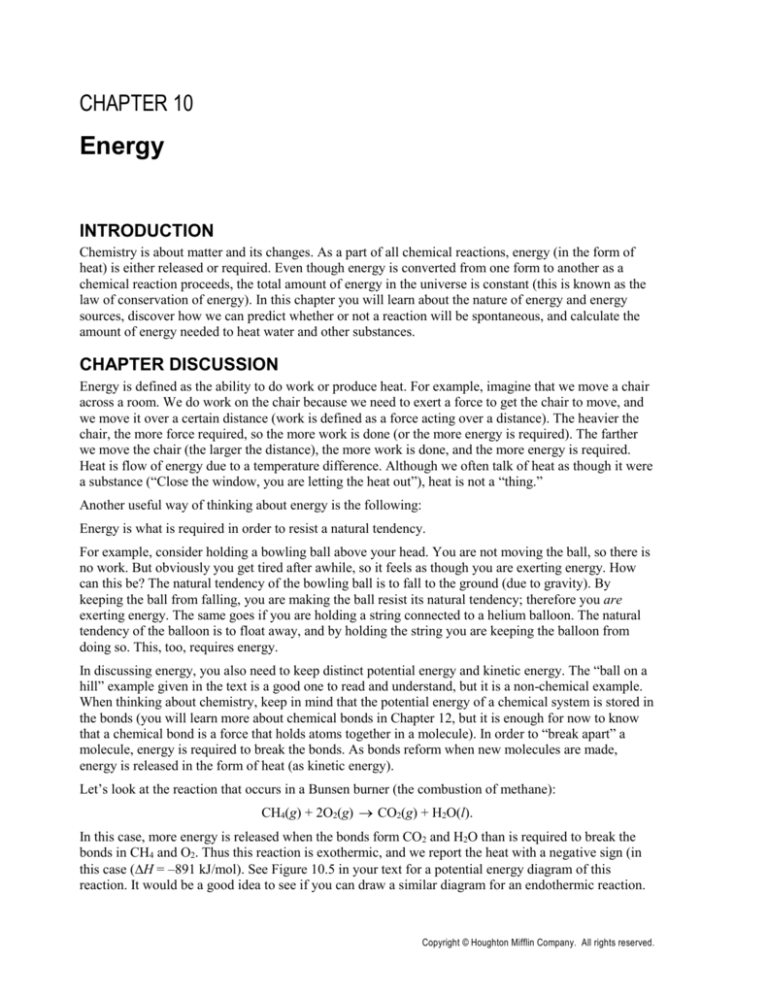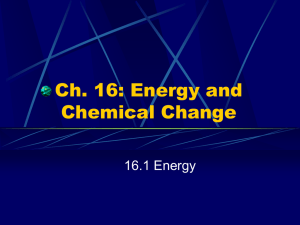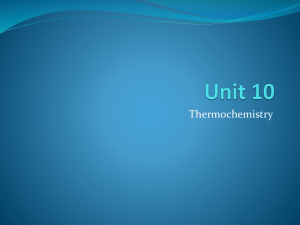
CHAPTER 10
Energy
INTRODUCTION
Chemistry is about matter and its changes. As a part of all chemical reactions, energy (in the form of
heat) is either released or required. Even though energy is converted from one form to another as a
chemical reaction proceeds, the total amount of energy in the universe is constant (this is known as the
law of conservation of energy). In this chapter you will learn about the nature of energy and energy
sources, discover how we can predict whether or not a reaction will be spontaneous, and calculate the
amount of energy needed to heat water and other substances.
CHAPTER DISCUSSION
Energy is defined as the ability to do work or produce heat. For example, imagine that we move a chair
across a room. We do work on the chair because we need to exert a force to get the chair to move, and
we move it over a certain distance (work is defined as a force acting over a distance). The heavier the
chair, the more force required, so the more work is done (or the more energy is required). The farther
we move the chair (the larger the distance), the more work is done, and the more energy is required.
Heat is flow of energy due to a temperature difference. Although we often talk of heat as though it were
a substance (“Close the window, you are letting the heat out”), heat is not a “thing.”
Another useful way of thinking about energy is the following:
Energy is what is required in order to resist a natural tendency.
For example, consider holding a bowling ball above your head. You are not moving the ball, so there is
no work. But obviously you get tired after awhile, so it feels as though you are exerting energy. How
can this be? The natural tendency of the bowling ball is to fall to the ground (due to gravity). By
keeping the ball from falling, you are making the ball resist its natural tendency; therefore you are
exerting energy. The same goes if you are holding a string connected to a helium balloon. The natural
tendency of the balloon is to float away, and by holding the string you are keeping the balloon from
doing so. This, too, requires energy.
In discussing energy, you also need to keep distinct potential energy and kinetic energy. The “ball on a
hill” example given in the text is a good one to read and understand, but it is a non-chemical example.
When thinking about chemistry, keep in mind that the potential energy of a chemical system is stored in
the bonds (you will learn more about chemical bonds in Chapter 12, but it is enough for now to know
that a chemical bond is a force that holds atoms together in a molecule). In order to “break apart” a
molecule, energy is required to break the bonds. As bonds reform when new molecules are made,
energy is released in the form of heat (as kinetic energy).
Let’s look at the reaction that occurs in a Bunsen burner (the combustion of methane):
CH4(g) + 2O2(g) CO2(g) + H2O(l).
In this case, more energy is released when the bonds form CO2 and H2O than is required to break the
bonds in CH4 and O2. Thus this reaction is exothermic, and we report the heat with a negative sign (in
this case (H = –891 kJ/mol). See Figure 10.5 in your text for a potential energy diagram of this
reaction. It would be a good idea to see if you can draw a similar diagram for an endothermic reaction.
Copyright © Houghton Mifflin Company. All rights reserved.
Chapter 10: Energy
93
You should also be able to differentiate between heat and temperature. Specifically, make sure you
understand that heat and temperature are not the same. Temperature is a measure of the random motions
of the particles that make up a substance. The concept of specific heat capacity helps us see this
difference. You undoubtedly have seen that different substances change temperatures differently when
the same amount of heat is transferred. For example, if you are making soup on the stove and are
stirring with a metal spoon, you notice that the spoon gets hot rather quickly. A wooden spoon does not
get nearly so hot, even though the amount of heat is the same. Why is this? Different substances, due to
their make-ups, react to heat differently. We quantify this with the specific heat capacity, which is
defined as the amount of energy required to change the temperature of one gram of the substance by
one Celsius degree. See Table 10.1 in your text for a list of specific heat capacities, and notice that the
heat capacities of metals are lower than water. This means that the temperature of a given mass of metal
will increase much more than the temperature of the same mass of water when the same amount of heat
is transferred to each. Practice doing problems dealing with specific heat capacities to make sure you
can either use heat capacities to calculate temperature differences or that you can calculate heat
capacities and determine the substance that is being heated or cooled.
You will also be expected to calculate the heat (enthalpy) of a reaction from known heats of related
reactions. You can do this using Hess’s law, which works because energy is a state function. Make sure
you understand how Hess’s law uses the idea that energy is a state function (another way of stating this
is to rely on the existence of the first law of thermodynamics – make sure you know why).
While energy is conserved (that is the quantity stays the same), the quality of energy is constantly
decreasing. That is, the amount of usefulness in a sample of energy decreases as the energy is “used.”
The example used in your text is gasoline. A sample of gasoline can be thought of as concentrated
energy (potential energy). However, as you drive the car heat is released to the road, the air, etc., and
so, while the amount of energy in the universe is the same before and after you drive your car, the
usefulness has decreased. Natural processes always occur in a way that increases the “spreading” of
energy and thus decreases the usefulness of the energy. We term this entropy, which is a measure of
disorder. For a process to be spontaneous, the entropy of the universe must increase.
LEARNING REVIEW
1.
Explain the difference between kinetic energy and potential energy.
2.
Why isn’t all energy available as work?
3.
The law of conservation of energy means that energy is a state function. Explain why.
4.
Explain differences among heat, temperature, and thermal energy.
5.
Provide a molecular-level explanation of why the temperatures of a cold soft drink and hot coffee
in the same room will eventually be the same.
6.
In which case is more heat involved: mixing 100.0-g samples of 90 C water and 80 C water or
mixing 100.0-g samples of 60 C water and 10 C water? Assume no heat is lost to the
environment.
7.
What is meant by potential energy in a chemical reaction? Where is it located?
8.
Are the following processes exothermic or endothermic?
a.
When solid KBr is dissolved in water, the solution gets colder.
b.
Natural gas (CH4) is burned in a furnace.
c.
When concentrated sulfuric acid is added to water, the solution gets very hot.
d.
Water is boiled in a tea kettle.
Copyright © Houghton Mifflin Company. All rights reserved.
94
9.
Chapter 10: Energy
In thermodynamics the chemist takes the system’s point of view. What does this statement mean?
10. A gas absorbs 45 kJ of heat and does 29 kJ of work. Calculate E.
11. Convert the energy values below to the desired units.
a.
45.8 cal to J
b.
0.561 cal to J
c.
5.96 J to cal
d.
76 J to cal
12. Calculate the number of calories required to change the temperature of each of the quantities of
water below.
a.
100.1 g of water from 6°C to 25°C
b.
2.32 g of water from 36°F to 42°F
c.
40 g of water by 12°C
d.
16.9 g of water from 75.0°C to 80.0°C
13. How much energy (in joules) is required to raise the temperature of 25.2 g of solid carbon rod
from 25 °C to 50.°C? The specific heat capacity of solid carbon is 0.71 J/g °C.
14. How much energy (in calories) is required to raise the temperature of 10. g steam from 122.2 °C
to 130.4 °C? The specific heat capacity of water(g) is 2.0 J/g °C.
15. How much of a temperature change would occur if 2736.8 J of energy were applied to a piece of
iron bar weighing 450.5 g? The specific heat capacity of solid iron is 0.45 J/g °C.
16. What is the mass in grams of a piece of aluminum wire if a change in temperature of 5.67 °C
required 8.53 J? The specific heat capacity of solid aluminum is 0.89 J/g °C.
17. What is the specific heat capacity of ethyl alcohol if 1972.4 J of energy is necessary to raise the
temperature of 53.4 g ethyl alcohol by 15.2°C?
18. Calculate the enthalpy change when 1.00 g of methane is burned in excess oxygen according to
the reaction CH4(g) + 2O2(g) CO2(g) + H2O(l) (H = –891 kJ/mol).
19. Given the following data:
C2H2(g) + 52 O2(g) 2CO2(g) + H2O(l)
C(s) + O2(g) CO2(g)
H2(g) + 12 O2(g) H2O(l)
H = –1300. kJ/mol
H = –394 kJ/mol
H = –286 kJ/mol
calculate H for the reaction
2C(s) + H2(g) C2H2(g)
20. What is the difference between the quality of energy and the quantity of energy? Which is
decreasing?
21. Which energy sources used in the United States have declined the most in the last 150 years?
Which have increased the most?
22. Why can’t the first law of thermodynamics explain why a ball doesn’t spontaneously roll up a
hill?
Copyright © Houghton Mifflin Company. All rights reserved.
Chapter 10: Energy
95
23. Exothermic reactions have a driving force. Nevertheless, water melting into a liquid is
endothermic, and this process occurs at room temperature. Explain why.
ANSWERS TO LEARNING REVIEW
1.
Kinetic energy is the energy of motion. Potential energy is the energy of position.
2.
Some energy is given off in other forms such as heat or light.
3.
Because energy is conserved in any process, the pathway of the process does not matter. This
means that energy is a state function.
4.
Heat is a flow of energy due to a temperature difference; temperature is a measure of the average
kinetic energy of a substance; thermal energy comes from the random motion of the components
of the system.
5.
Temperature is a measure of the average kinetic energy of the samples. The “coffee particles”
(mostly water molecules) are of higher average kinetic energy than the “air particles” (a mixture
of mostly nitrogen and oxygen molecules) in the room, which are of higher energy than the “soft
drink particles” (mostly water molecules). At the coffee-air interface, a collision of higher-energy
“coffee particle” and “air particle” results in energy being transferred from the coffee to the room.
Transfer also occurs from air to soft drink because “air particles” are of higher energy than the
“soft drink particles” (due to the temperature difference). The energy transfers result in the
eventual average kinetic energies of each sample being equal, which means the temperatures are
equal. Because the volume of air is so large (the system is open), however, no noticeable
temperature change of the air will result.
6.
There is more heat involved in mixing 100.0-g samples of 60 °C and 10 °C water because there is
a large temperature difference (and heat is a flow of energy due to a temperature difference).
7.
The potential energy is the energy available to do work. Potential energy in a chemical reaction is
stored in the chemical bonds.
8.
9.
a.
endothermic
a.
exothermic
b.
exothermic
c.
endothermic
The chemist chooses the sign based on whether energy flows from the system (negative sign) or
into the system (positive sign).
10. ∆E = q + w = 45 kJ + (–29 kJ) = 16 kJ
11. Converting calories to joules or joules to calories requires knowing that 1 cal = 4.184 J.
a.
45.8 cal
b.
0.561 cal
c.
5.96 J
4.184 J
= 192 J
1 cal
4.184 J
= 2.35 J
1 cal
1 cal
= 1.42 cal
4.184 J
Copyright © Houghton Mifflin Company. All rights reserved.
96
Chapter 10: Energy
d.
76 J
1 cal
= 18 cal
4.184 J
12. These problems ask you to calculate the calories required to heat a quantity of water. One calorie
is defined as the amount of heat required to raise the temperature of 1 gram of water by 1 degree
Celsius. To solve these problems, you need to multiply the number of grams of water to be heated
by the number of degrees Celsius change in the temperature of the water.
1 cal
= 1900 cal
g water C
a.
100.1 g water 19C
b.
The initial and final temperatures of water are given in °F. We must convert to °C before
solving the problem.
Initial temperature:
T°C =
(T F 32)
1.80
T°C =
(36 32)
1.80
T°C = 2.2
Final temperature:
T°C =
(T F 32)
1.80
T°C =
(42 32)
1.80
T°C = 5.6
Temperature change:
5.6 °C − 2.2 °C = 3.4 °C
Solution: 2.32 g water 3.3C
1 cal
= 7.9 cal
g water C
1 cal
= 480 cal
g water C
c.
40. g water 12C
d.
16.9 g water 5.0C
1 cal
= 85 cal
g water C
13. In this problem we want to calculate the heat energy needed to raise the temperature of a
substance other than water. To do this, we need to know the specific heat capacity of the
substance. The specific heat capacity tells us the amount of heat energy required to change the
temperature of 1 gram of a substance by 1 degree Celsius. Every substance has its own specific
heat capacity. That of solid carbon is 0.71 J/g °C.
If it takes 0.71 J to raise the temperature of 1 gram of carbon 1 degree Celsius, then it will take
0.71 J × 25.2 to raise 25.2 g carbon by 1 degree Celsius. We wish to raise the temperature of the
carbon rod by 25 °C, not 1 °C. We will need twenty-five times the heat energy needed to raise the
temperature of 25.2 g carbon by 1 degree Celsius.
Copyright © Houghton Mifflin Company. All rights reserved.
Chapter 10: Energy
Joules =
97
0.71 J
25.2 g carbon 25C
g carbon C
The joules required to raise the temperature of 25.2 g carbon by 25 °C = 450 J.
14. When you are given the number of grams of a substance, a change in temperature in degrees
Celsius, and the specific heat capacity for that substance and are asked to calculate the heat energy
required, you can use the formula Q = s × m × ΔT. The specific heat capacity is s, m equals the
mass in grams, ΔT is the change in temperature in degrees Celsius, and Q is the heat energy
required. We can solve this problem with the formula although we will need to convert Q from
joules to calories since calories are asked for.
Q = s × m × ΔT
Q=
2.0 J
10. g water(g ) 8.2 C
g water(g ) C
Q = 160 J
The answer should be expressed in calories:
160 J
1 cal
= 38 cal
4.184 J
15. In this problem, we are given Q, the heat energy in joules; m, the mass in grams of a piece of iron;
and s, the specific heat capacity of iron. We are asked for ΔT, the change in temperature. If we
rearrange the equation Q = s × m × ΔT, we can solve for ΔT.
Divide both sides by ΔT.
Q
=s m
T
Now, divide both sides by Q (same as multiplying by
1
).
Q
Q
1
s m
=
T
Q
Q
We now have 1/ΔT (the inverse of ΔT) isolated on one side of the equation.
1
s m
=
T
Q
Invert both sides of the equation.
T
Q
=
1
s m
T
Q
= T =
1
s m
Copyright © Houghton Mifflin Company. All rights reserved.
98
Chapter 10: Energy
Now, find ΔT.
2736.8 J
0.45 J
450.5 g
g C
T =
ΔT = 14 °C
16. In this problem we are asked to solve for mass, m. We are given ΔT, Q, and s. We can rearrange
the equation as illustrated below.
Divide both sides of the equation by m.
Q s m T
=
m
m
Divide both sides of the equation by Q.
Q
1
1
= s T
m
Q
Q
1
s T
=
m
Q
Invert both sides of the equation.
m
Q
=m=
1
s T
Now, find m.
m=
8.53 J
0.89 J
5.67 C
g C
m = 1.7 g
17. We are asked to find the specific heat capacity, s, when given ΔT, Q, and m. Rearrange the
equation to isolate s on one side of the equation.
s=
Q
m T
Now substitute values into the equation.
s=
1972.4 J
= 2.43 J/g °C.
54 g 15.2 C
The specific heat capacity of ethyl alcohol is 2.43 J/g °C.
Copyright © Houghton Mifflin Company. All rights reserved.
Chapter 10: Energy
18.
99
1 mol CH4
891 kJ
= 55.5 kJ
16.04 g CH4
1 mol CH4
1.00 g CH4
2C(s) + 2O2(g) 2CO2(g)
H = 2(–394 kJ/mol)
H2(g) +
1
2
O2(g) H2O(l)
H = –286 kJ/mol
2CO2(g) + H2O(l) C2H2(g) +
5
2
O2(g)
H = –(–1300. kJ/mol)
2C(s) + H2(g) C2H2(g)
H = 226 kJ/mol
19. The quality of energy tells us the form of the energy (potential or kinetic). The quantity of energy
tells us how much. The total amount (or quantity) is conserved. However, when potential energy
is converted to kinetic energy, we say the quality is decreasing.
20. Wood has decreased the most. Nuclear and petroleum/natural gas have increased the most (see
Figure 10.7).
21. The first law of thermodynamics tells us the total amount of energy is constant. It does not tell us
anything about the direction of energy transfer.
22. The energy of the surroundings is used to melt solid water. The temperature of the water will
eventually reach that of the room, and room temperature is higher than the melting point of water.
In addition, liquid water has greater entropy than solid water, so entropy is the driving force in this
process.
Copyright © Houghton Mifflin Company. All rights reserved.










